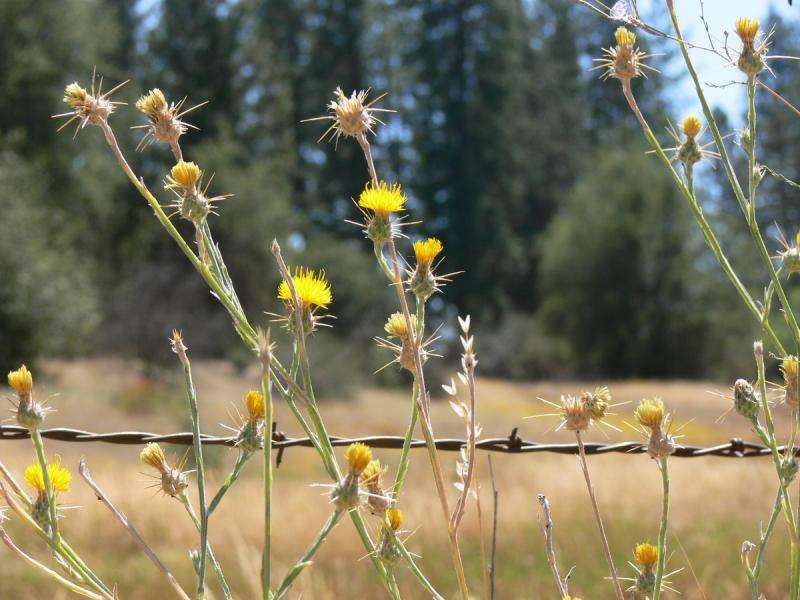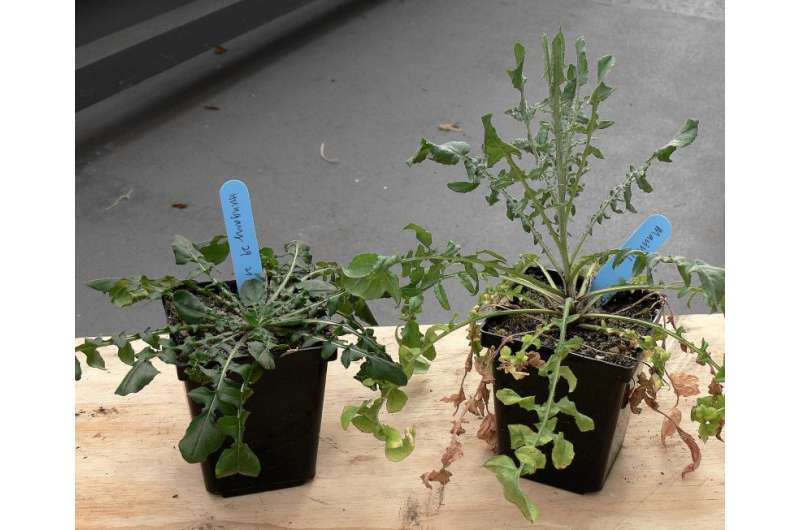When plants become space invaders

Declines in native biodiversity can open opportunities for imported species to not only grab a foothold in a new territory, but also to evolve into invasive pests.
The evolution of an invasive plant is likely aided by the decline of native species, new research led by University of Arizona scientists shows.
The decline of native biodiversity can do more than make room for imported species to become rooted in their new habitat. It also can enable them to evolve into invasive pests, according to the study published online in the journal Nature Plants.
While introduced plants—crops, ornamentals or weeds spread by human activity—are common, not all become invasive. Invasive species have found a way to become vigorous on their new turf.
"Our big goal is to determine how species become invasive." said lead author Katrina Dlugosch, assistant professor in the Department of Ecology and Evolutionary Biology in the UA's College of Science. "In this study, we've determined that a plant invader not only had an opportunity to enter an ecosystem after native biodiversity declined, but it was able to exploit that opening to evolve more aggressive growth and spread."
It is thought that invasive species will flourish when they can gain an edge over natives by using resources in a different way.
"A plant's ecological niche is defined by the resources it needs to survive," Dlugosch explained. "When plants have overlapping needs, they compete. We already know that declines in biodiversity caused by climate change and human alterations to the environment provide opportunities for invaders by reducing native competition for resources. What we have discovered here is that those declines can also serve as a jumping-off point for species to evolve into something much more problematic."
The study focused on yellow star-thistle, which is more successful here than in its native range in Eurasia and has become one of the worst weeds in the American West.

"It causes economic harm because it deters grazing animals and sickens horses," Dlugosch said. "It's also an ecological problem because it quickly became very abundant and now dominates the plant community."
Co-author Alice Cang, a doctoral student in the Department of Ecology and Evolutionary Biology, said yellow star-thistle "became an aggressive invasive after declines of native late-season annuals had been noted."
To measure evolutionary change in the invading plants, the research team set up a greenhouse experiment to compare the growth and reproduction of plants from 20 populations across the invaders' range in California and 22 populations from its native range in Europe. They found that California plants grew almost 50 percent larger than their native peers within less than a month—and produced more flowering heads over their lifetimes.
Water is known to be a critical limiting resource for yellow star-thistle and other similar late-season annual plants, Dlugosch said. Yet, when half of the plants were subjected to drought conditions midway through the experiment, California plants wilted faster than their European counterparts. These results show that invasive yellow star-thistle is more dependent on water availability, despite the limited amount of this resource.
As part of the study, the researchers showed that yellow star-thistle grows in very similar Mediterranean climates in both California and Europe. In fact, many of the California locations are warmer and drier than those in Europe, suggesting that a lack of competitors—rather than a wetter climate—is making water more available to the invader.
The history of yellow star-thistle's invasion reveals how it became more water-dependent and larger as it evolved in California's warmer and drier climate.
Yellow star-thistle first sneaked into the U.S. with bales of alfalfa seed in the 1800s, but it did not become a pest until much later. Cattle ranching and tilling contributed to an increase of non-native grasses and a decrease of native annual wildflowers. Droughts in the early 1900s hit native species when they were down, further decimating biodiversity until natives became extremely rare.
This opened up a time in the late summer when few plants were around to consume water, and yellow star-thistle took advantage. As a deep-rooted late-summer annual, it is able to withstand drought under warm summer conditions.
Other experiments revealed that invasive yellow star-thistle does not do well when competing with native summer annuals for water.
"The problem is that the native annuals are no longer around to compete with yellow star-thistle," Cang explained.
According to the researchers, the simplest explanation for the aggressive spread of the yellow star-thistle is the loss of native late-summer annual plants.
Recently, ecologists have made a case for why introduced species that fill vacated niches can be good for the environment. They argue that these new inhabitants may provide valuable ecosystem services such as supporting pollinators or preventing erosion.
"Our work cautions that even if an introduced species is filling a vacant niche and seems benign at first, it may evolve to be a more aggressive pest later," Dlugosch said.
More information: "Evolution of invasiveness through increased resource use in a vacant niche" Nature Plants 1, Article number: 15066 (2015) DOI: 10.1038/nplants.2015.66
Journal information: Nature Plants
Provided by University of Arizona

















